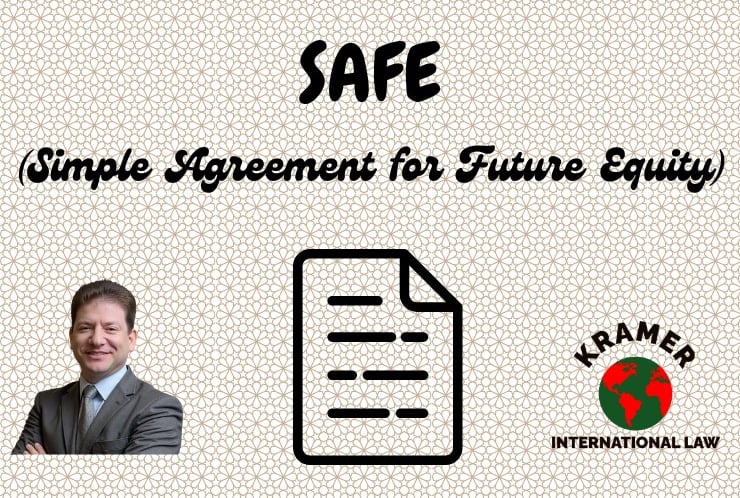Simple Agreements for Future Equity (SAFEs): (Part 1 of 2)
May 6, 2025
Randy S. Kramer


Simple Agreements for Future Equity (SAFEs): (Part 1 of 2)
Simple Agreements for Future Equity (SAFEs) have gained immense popularity, becoming a standard tool for early-stage startup investments. SAFEs provide significant benefits, including speed and cost efficiency, but also come with pitfalls and complexities that require careful consideration.
The current application of SAFEs significantly deviates from their original purpose, leading to further complications. In this part 1 of a two-part series, I delve into the background of SAFEs, highlight their benefits, and examine the challenges that arise from their misuse. Additionally, I analyze the pros and cons and clarify widespread misconceptions.
SAFEs Are Options, Not Shares
Over the past ten years or so, SAFEs have become a favored method for securing capital. But what exactly are SAFEs? Where did they come from, and why are they utilized? This section addresses these essential questions.
SAFEs are financial tools that startups utilize primarily to attract investment from angel investors and occasionally from very early-stage venture capitalists. They have become increasingly popular as an alternative to traditional equity financing methods, such as common or preferred stock.
Both SAFEs and equity rounds, including standard Series A or Series B rounds, function as ways for early-stage startups to raise capital. Nevertheless, they differ markedly in their structure and their timing.
Equity rounds involve an immediate exchange of ownership shares for investment, which establishes a valuation for the startup at that moment.
However, arriving at an accurate valuation may not be feasible during the initial stages of a startup's development. Startups often lack customer traction, essential performance metrics, or revenue streams that would typically be used to draw up a valuation.
In contrast, SAFEs delay the valuation conversation until a later, more significant funding event or, in some instances, a specific triggering event. This strategy allows both founders and investors to prioritize what truly matters at this early stage: developing a viable product and growing the business, while avoiding complex negotiations as to valuation.
When the next priced equity round (i.e., a round with a set price per share) occurs, SAFEs are generally converted into shares of the startup, following the predetermined terms agreed upon in the SAFE agreement.
This postponement of valuation discussions streamlines and accelerates the fundraising process and makes SAFEs a preferred option for startups seeking quick access to capital. However, it introduces a level of uncertainty, as the actual equity distribution will be determined at a later date, potentially impacting the share of investors.
Compensating for Risk: Valuation Caps and Discount Rates
Investors in SAFEs should receive suitable compensation for the significant risks they take on. They provide capital during a company’s early stages, often when ideas are still unproven and traction is minimal. In contrast, later investors are poised to benefit from the advancements made with the funds raised via SAFEs.
SAFEs utilize mechanisms for risk-reward, such as valuation caps and discount rates, to ensure that early supporters are rightfully rewarded for their confidence in the startup’s potential.
Valuation Cap: This cap establishes a maximum limit on the SAFE’s conversion price into equity during future financing rounds. As a result, even if the startup’s valuation increases dramatically, the conversion price for the investor will not surpass the cap. For example, suppose an investor has a SAFE with a $2 million valuation cap and the next funding round values the startup at $6 million. In that case, the SAFE will convert equity at the capped price, granting the investor three times the equity for their investment.
Discount Rate: The discount rate allows investors to buy shares at a set discount compared to the price for new investors in the subsequent equity round. This discount reflects the risk that early investors undertook by investing in the venture before its value was established. Discounts usually range from 10% to 30%, which offers investors a favorable conversion rate and encourages early involvement. The higher the discount rate, the more the founders’ shares are diluted.
Pre-Money SAFEs and Post-Money SAFEs
Pre-money SAFE: In a pre-money SAFE, the valuation at which the SAFE holder’s investment turns into equity is set before incorporating new capital from the following equity financing round (e.g., a Series A financing round).
With a pre-money SAFE, each new SAFE holder dilutes other shareholders, including the founders, when there are multiple SAFE investors. Because the ownership of each SAFE holder is determined only when a new financing round occurs, investors and founders face significant uncertainty as to the percentages of the company's equity they would own before the event, such as a Series A financing round, that triggers the conversion of a SAFE investment into shares.
With a pre-money SAFE, investors will need to wait for the new equity financing round and the conversion of all SAFEs to determine how much equity they own in the company.
Post-money SAFE: Unlike pre-money SAFEs, a post-money SAFE incorporates the funds from the SAFE holder in its valuation cap. Consequently, the conversion valuation of the SAFE reflects the startup’s worth after including the SAFE amount but before any new equity financing (such as a Series A round) takes place. This ensures that the SAFE holder’s equity stake remains unaffected by new equity investors in the same funding round.
The key distinction between a post-money SAFE and a pre-money SAFE is that SAFE investors secure a specific percentage of equity relative to other shareholders, which includes other SAFE investors. This occurs because a post-money valuation cap is applied, accounting for all investments in that particular “SAFE round”.
With a post-money SAFE, the company's capitalization is made up of the pre-conversion capitalization (which includes shares owned by founders and any other stakeholders on the cap table prior to conversion) plus the shares issued when SAFEs are converted.
A post-money cap takes into account the pre-money number of shares plus the investment shares from convertible securities such as SAFEs. This ensures that the SAFE holders can lock in a percentage of equity in relation to other SAFE investors and pre-round shareholders.
Post-money SAFEs also make things simpler for SAFE investors. For example, if the post-money valuation cap on their SAFE comes to 6%, then the SAFE investor knows they will own 6% of the company at the time of the conversion of their SAFE into shares the company.
Post-money SAFEs offer advantages for founders as well. Depending on the situation, understanding the exact percentage of your company you are currently relinquishing can be beneficial. This clarity can also streamline negotiations with investors, rendering them quicker, easier, and more transparent.
Keep in mind, however, that the conversion event (e.g. Series A financing round) will dilute the SAFE investors, leaving them uncertain about their exact ownership percentage after that event.
International Business Law Firm
Providing international business law services respecting the law of the US, Canada, and the UK
Serving growth companies, startups, and investors
TO CONTACT US:
E: info@kramerintlaw.com
T (US): + 1.347.588.4060, Ext. 1010
© 2025 Kramer International Law
All rights reserved.


T (Can): + 1.514.470.0717, Ext. 1010
